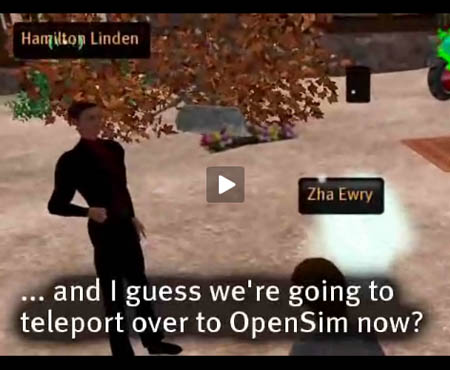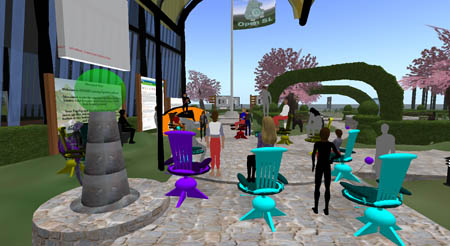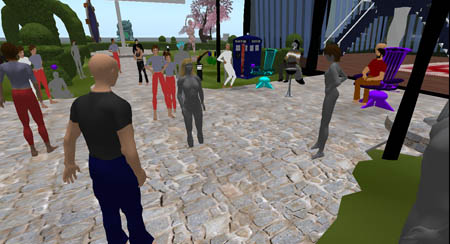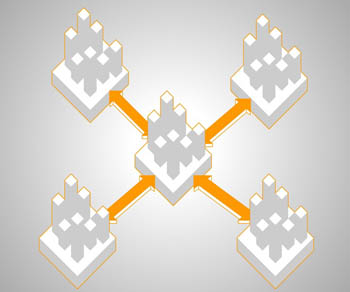Today it is official, “The IBM and Linden Lab Interoperability Announcement” – see also, Torley Linden’s video here (screenshot above).
Hamilton Linden and Inifinty Linden visited OpenSim office hours in Wright’s Plaza, OSGrid, last week with some big news (screenshot below). 25 avatars gathered to discuss with great enthusiasm Hamilton Linden’s proposal that Linden Lab would provide an Open Beta for the Open Grid Protocol for login and teleport between OpenSim and the Linden Lab Public Open Grid Beta.
This interoperability work has been pioneered by David Levine (IBM researcher, Zha Ewry in Second Life) in conjunction with Linden Lab’s Architecture Working Group. Zha has personally coded the patch and she blogged her progress on this last month. Zha’s interop patch can be viewed here.
Later in this post for Zha’s gives an outline of the steps that could lead to the advent of much anticipated and hotly debated content interoperability.
Why is this Interoperability Initiative so important?
While, in Zha’s words, “this is a proof of concept of protocol.†It is an important first step, not only toward realizing Linden Lab’s dream of expanding the influence of their technology, but for consolidating a heterogenous mix of applications for virtual worlds in an interoperable environment.
Notably, it will allow corporations to deploy private and exploratory grids on OpenSim technology while remaining interoperable with the largest virtual world community to date, Linden Lab’s Second Life.
But it is not only interoperability between Second Life and OpenSim which will unleash the power of virtual worlds, it is interoperability between OpenSim grids. New OpenSim grids like Tribal Net and innovative projects like realXtend are beginning to discuss consolidating their influence through interoperability.
Both Tribal Net and realXtend have led the way re innovation with OpenSim technology (see my posts here, here, here for realXtend and here for Tribal Net). And, both are now in early discussions with OSGrid re interoperability. Charles Krinke, a developer and very excellent open source community organizer, runs OSGrid. He gave me a some background on OSGrid (see an upcoming post for more).
OSGrid is the second oldest OpenSim grid and was created in July, 2007. I began running it in August with 150 users and a dozen regions. Others were brought in as managers, most notably “Nebadon Izumi”, “Hiro Protagonist”, “Paulie Flomar” and more in the fall. We now have 3200 users and nearly 400 regions attached as of early July, 2008.
There are two goals for OSGrid. One is to test the OpenSim releases on a daily basis and the other is to build a healthy community.
Interoperability and consolidation of virtual worlds is vital to their development not only because Metcalfe’s law states that “the value of a telecommunications network is proportional to the square of the number of users of the system†but because Second Life has demonstrated that one of the key contributions of Virtual Worlds so far is their potential to collapse geography (as Cory Ondrejka put it).
Open Virtual Worlds must continue to create new and richer forms of networked interaction, enabling the communication not only of personal identities, but of community identities and cultures in ways not possible or imagined before. This potential cannot be fulfilled by small isolated worlds.
A New Era for Virtual Worlds Begins!
The excitement was palable today in meetings held in Second Life and OpenSim that discussed moving the interoperability initiative forward.
Interoperability is a big deal. This much was clear. And the press were on it! Eric Reuters showed up in the OpenSim IRC today asking questions about IP and virtual economies in the Open Metaverse. And, there are many posts already including TechCrunch, Information Week, Virtual World News, Gamasutra, and Dusan Writer‘s.
In the IBM press release, Colin Parris, Vice President, Digital Convergence, IBM said. “Developing this protocol is a key milestone and has the potential to push virtual worlds into the next stage of their evolution.â€
The screenshot above is from OpenSim office hours today, Wright’s Plaza, OSGrid. There were 31 avatars present including Zha Ewry, avatar of David Levine, IBM, and at least four Lindens – Hamilton Linden, Tess Linden, Whump Linden, and Periapse Linden (Whump and Periapse are running the Linden Lab Public Open Beta Grid).
Also, there were many of the key OpenSim developers, Adam Johnson and Jeff Ames dropped in from Genkii, Japan (see here for more). There were several avatars from IBM in addition to Zha, and members of the Microsoft Development Community in OpenSim, notably G2 Proto, were there.
In the foreground of the screenshot above you can see the OpenSim avatar of Mic Bowman, Principal Engineer from Intel, Finrod Meriman. Mic is an important advocate for Interoperable Virtual Worlds and active member of the OpenSim development community. This was a power house gathering signalling interoperability as the future of virtual worlds has arrived.
Hamilton announced the link for the Public Open Grid Beta, and told the gathering:
You just need to contact Periapse or Whump Linden and they’ll get you setup. Although, we’re are officially committing to July 31st to start. But we’d obviously like to do it sooner. When it starts they’ll give you the info for the downloadable viewer and access to the Agent Domain Host.
Steps Towards Content Interoperability: Interview with Zha Ewry.
Interoperability will raise many new social/business questions for virtual worlds (particularly re content and business models). However, because this proof of concept is between the Linden Lab Public Open Grid Beta, which is not part of the Second Life economy, and OpenSim there is time for some of these questions to be explored.
This exploratory process began at a large meeting held by Zero Linden last week that focused on some of the community concerns about interoperability (see transcript here).
I asked Zha Ewry what she saw as the steps that would lead to content traveling back and forth between Second Life and OpenSim. The movement of content is where most of the thorny social/legal/business questions around interoperability emerge.
Zha outlined what the technical steps would be while noting that the social questions were just beginning to be explored:
Zha: There are a series of about four technical/social/legal steps.
First, we need a protocol for establishing proof of identity between
the components. ie for the sims and services to cross prove they are
who they claim to be, which is peer to having a trusted identity for
the users.
Second, we need a way of expressing policy This is orthogonal to one,
but pretty much requires the proof of identity in order to be useful.
In particular, we want to be able to express what the content creator
desires, including whether they wish it to be restricted to a grid, or
set of grids, copy and use and so on.
Third, we need an agreed public protocol for asset fetch including
both copy, and ACID fetch, and a reliable way of managing no-copy
assets. This is the brute work of moving the digital assets around,
and would exploit one and two to determine if assets should be movable
at all.
Fourth you would want the legal and social framework for using the
technical capabilities. This would be akin to a Terms of Service for
connecting stuff together, which would spell out what policies were in
place. effectively, these become the specific agreements which couple
the first three together, so that we have a safe, agreed way of moving
only the publically accessible assets (we can in fact, do parts of
this, in parallel, so we could work on 3) with public domain assets,
on a set of sims, that only had public assets) while working on 1 and
2.
A lot of this takes on a flavor of building up a layered set of
abilities, and then allowing people to compose a range of possible
solutions. At the protocol level, we want to allow a lot of
flexibility so different grids and communities can explore different
strategies. This is not about a one size fits all approach, or about
having a good enough crystal ball to pick an approach. An open source
community, with open protocols has the luxury of encouraging
experimentation.
Tish: So have the proof of identity protocols been published in any
current AWG docs or worked on?
Zha: It has been discussed, but not in any detail
Tish: So on the agenda?
Zha: Oh, very much so!
For an in depth and somewhat technical discussion of how issues of IP, trust, and managing permissions, licenses etc. might be managed with interoperable virtual worlds see the chatlog from todays Architectural Working Group Groupies discussion.
Content is already on the move in the Open Metaverse
Tribal Net announced this week that Second Inventory is now working on Tribal:
This software lets you backup and restore content to and from different grids, like for example the Second Life(tm) grid, and Tribal Net – which makes Tribal Net an excellent tool to work in private or offline with content, or to make and transfer objects thru e-mail or the web. (You can now distribute your Second Life(tm) object thru your blog – literally!)
Also Tribal annoinced they have 200 members, “and 150 of those has published their own islands. We now have a small core of dedicated 3D pioneers.â€
They have also started a community micro-blogosphere that you might want to check out.
Ron Andrade of Common.Sensible has been checking Tribal out and has written a nice post about what he has found. He also notes re the integration of Tribal with Second Inventory that this is not opened the door to all kinds of content transfer or theft.
Now don’t panic, all you against-theft-aggregations and I. P. advocates. You can only copy your inventory and you must be using the same avatar name on Tribal Net as you are using in Second Life. All the permissions remain the same. So, creators, fear not: your hard work is safe. Well, every bit as safe as it currently is in Second Life. Although it is unknown how scripts and other things will react. But hey, if you are the adventurous type with the resources and time, give it a shot.
Stefan Andersson of Tribal noted we should remember “the pioneering and experimental aspect of inter-grid content transfer, and that people should expect some bumps in the road.”






July 9th, 2008 at 2:01 pm
This was an exciting day for interoperability in the Metaverse-to-be… all things seem to be pointing in the right direction, all the key players we’ve been counting to push us forward into the InterGrid — the interconnected grid — seem to be as eager and excited to go ahead to the bright, shiny world that awaits us.
Meanwhile, on the other extreme, the “company that does not evil” launches Lively, the application to kill all other virtual worlds, by redefining what a virtual world is supposed to be: closed, proprietary, a mere attachment on a web page, and pretty irrelevant.
What a day!…
July 12th, 2008 at 2:50 am
i rushed to setup my sims on osgrid to be a part of this great advancement. i am jumping with anticipation now that i know Linden Lab won’t be “proprietizing” the sl grid. the fact that many aspect of virtual worlds communities are working on this raises faith in the progress of technology and shows that business focus can be separate to technological progression, something that a few other companies can learn from.
I will be trying my hardest to help out with this and test these protocols as we get deeper and deeper into that rabbit hole.
Here here on the “company that does no evil”. i logged in today to be greatly disapointed and could only lough to myself if they think this is going to compete with a real grid.
i offer hosting space via a new portal site i am working on called second rezzident. hoping to provide community access to allow each and all sub-gourp or community to be represented and self maintained.
July 21st, 2008 at 4:29 pm
As you know, I’ve been a big critic of this process which has favoured one school of thought among tekkies (copyleftism and extreme opensourcism) and not contained sufficient buy-in from content creators specifically and the public at large.
Zha keeps talking about “marking intent”. Intent is no good being marked, when the marking and intentions can’t be implemented technically.
When Zha says “Third, we need an agreed public protocol for asset fetch including
both copy, and ACID fetch, and a reliable way of managing no-copy
assets” — gosh, I’ll say! and that’s the part Zha has been most vague about, and others have been most cavalier and dismissive about, telling us a million times “if you can see it you can copy it” without an awareness that they need to create some kind of physical/technical barriers to theft in order to pronounce that theft indeed has taken place, and to provide at least a mild deterrent.
Both Zha and Adam are talking about “shallow DRM” by which they mean the mere marking of intent — marking is not sufficient. Marking became viable within SL because it had technical implementation to actually physically prevent casual copying or modding or reselling unless an explicit exploit was used. I’m just not hearing good enough answers to the blunt question of why all these opensource sims are neglecting this, leaving it to some putative third-party modules and ad-ons and plug-ins — that merely reflects their heavily copyleftist point of view.
BTW, Adam says that OpenSim is not a world, but merely a software.
So all those people standing together and working on something together in Wright Plaza, uh, are they in a world? Does puttering around on a platform not constitute a world, too? When does the world start and they leave off?